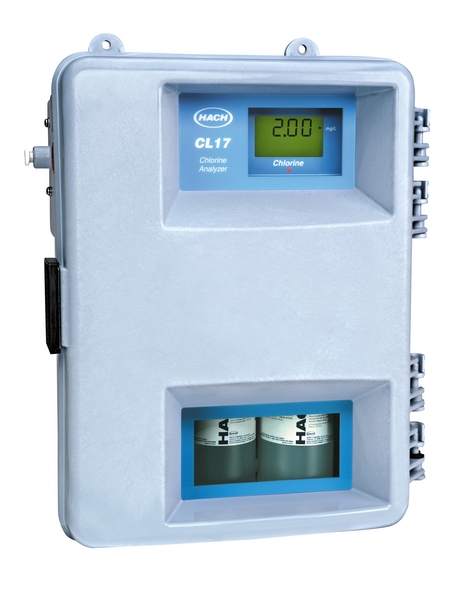- Hach Online Chlorine Analyzer
- Hach Cl17 Chlorine Analyzer User Manual Free
- Hach Cl17 Chlorine Analyzer
- Cl17 Chlorine Analyzer Manual
Page 1
5449089Cal Kit.fm
CL17 Free and Total Chlorine Calibration/Verification
54490-89
Instruction Sheet
CL17 Free and Total Chlorine Calibration/Verification
Guidelines for Use
Introduction
The CL17 Calibration/Verification Kit allows the user to perform a calibration or verification of
the analyzer using a chlorine standard of known concentration.
Recommended use
Under normal circumstances, Hach Company does not recommend manual calibration of the
CL17. Verification, however, is recommended following each change of analyzer reagents.
This can be performed either by comparison with a laboratory, a portable instrument or by
using the CL17 Calibration/Verification Kit.
Do you need reliable, real-time chlorine analysis to optimize your disinfection process or to report to regulatory agencies? The industry standard Hach CL17 Chlorine Analyzer uses colorimetric DPD chemistry to continuously monitor water for free or total chlorine. Ultra-low chlorine analyzer that measures the total chlorine concentration in dialysate water used for dialysis treatment. Measuring Instruments Hach Hach SL1000 Basic User Manual 160 pages Measuring Instruments Hach Lange DR 3900 User Manual 150 pages.
Certain regulatory agencies and other organizations require manual calibration or verification
of chlorine analyzers. Follow the guidelines set by those organizations to determine required
frequency of calibration.
Guidelines for Accuracy
Making and using chlorine standards with the accuracy needed to calibrate or verify the CL17
requires precisely controlled reagents, clean hardware and careful laboratory practice. Use
only the reagents specified in this instruction sheet and follow the instructions carefully. Failure
to do so may result in incorrect calibration forcing the analyzer to read inaccurately. To confirm
correct use of this kit, perform the statistical calculations described in
Figure 1
shows the two styles of analyzers under the CL17 name.
Figure 1
CL17 Analyzers
New Style CL17
Old Style CL17
CL17 Free and Total Chlorine Calibration/Verification
Page 3
5449089Cal Kit.fm
CL17 Free and Total Chlorine Calibration/Verification
9.
Open the front of the analyzer and slide the tube clamp onto the bypass line.
On old style analyzers, the bypass tubing will look similar, but the detector block is in
front of it.
10. Restore power to the analyzer. Make sure the 3-way luer lock valve is open so that
process stream water is flowing into the analyzer. See
Figure 4 on page 5
.
11. Turn the sample flow back on and make sure there are no leaks.
12. Allow the analyzer to complete a few measurements to clear the lines of air. If pump
tubing or new reagents were installed, then perform a prime cycle (refer to the
instrument manual).
Running the Zero Standard
1.
With sample flowing, reset the analyzer calibration to default values. From the Setup
Menu, choose Default Setup.
Note: To avoid contamination,
rinse the outside of the
calibration cap and flush the
calibration cap tubing with
deionized water before
inserting it into the standard.
This is particularly important
when calibrating multiple
instruments with a single
calibration set—getting chlorine
standard into the blank will
cause a false positive result.
Store the cap in the plastic
shipping bag when not in use.
2.
Open the front of the analyzer and pinch the drain bypass line shut with the clamp (if it
is not already pinched shut) to force the standard to flow through the reaction cell
instead of out to waste. Place the valve in Position B. See
Figure 2 on page 4
.
3.
Make sure the calibration cap has been cleaned inside and out with deionized water
(do not use Organic-free Water) and dried with a KimWipe
®
. Install the calibration cap
Hach Online Chlorine Analyzer
onto the zero standard (Organic-free Water), making sure the internal draw line (long
tube extending to bottom of bottle) reaches the bottom of the bottle and the vent line is
not submerged in liquid, see
Figure 5 on page 6
. The cap should be tight so that it can
hold pressure.
4.
Attach the end of the external portion of the draw line to the open port on the
3-way valve.
5.
Remove the check valve from the syringe and pull the plunger to fill the syringe with
air. (If the check valve is on the syringe when the plunger is pulled back, no air will be
drawn in.)

Note: The syringe is used to
pressurize the bottle so the
contents will flow into the
analyzer.
6.
Reinstall the check valve on the syringe. Install the syringe/check valve assembly onto
the vent line of the standard bottle.
7.
Place the standard bottle in a stable location higher than the analyzer (on top of the
CL17 analyzer is fine).
8.
Hach Cl17 Chlorine Analyzer User Manual Free
Watch the pinch valve to observe when the sample line is pinched shut (far left tube).
a.
Old Style Analyzer: Once it is pinched shut, wait 30 seconds and then inject all of
the air from the syringe. Leave the syringe on the vent line at this time.
Hach Cl17 Chlorine Analyzer
b. New Style Analyzer: Once it is pinched shut, wait one minute and then inject all of
the air from the syringe. Leave the syringe on the vent line at this time.
Cl17 Chlorine Analyzer Manual
9.
As soon as the pinch valve begins to open to allow flow through the sample line, turn
the 3-way valve to the “A” Position. You may be able to hear a rush of liquid going
through the tube into the analyzer and see the liquid level of the standard begin to
drop (on the old style analyzers it will drop more rapidly than on the new style
analyzers).
10. Immediately remove the check valve and syringe from the vent line.